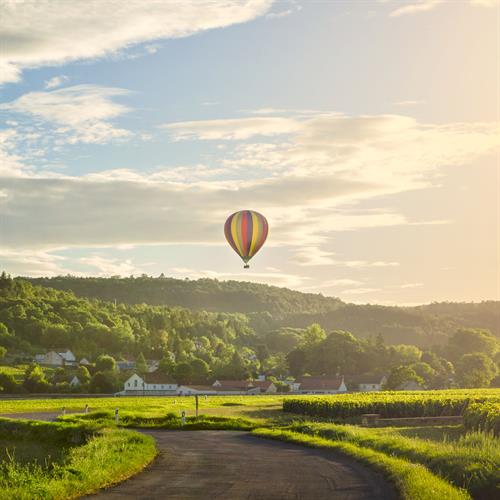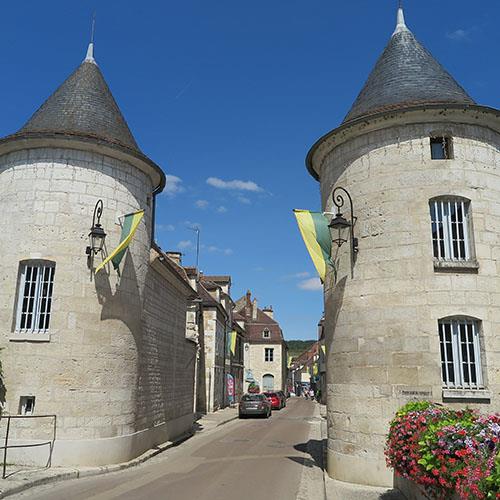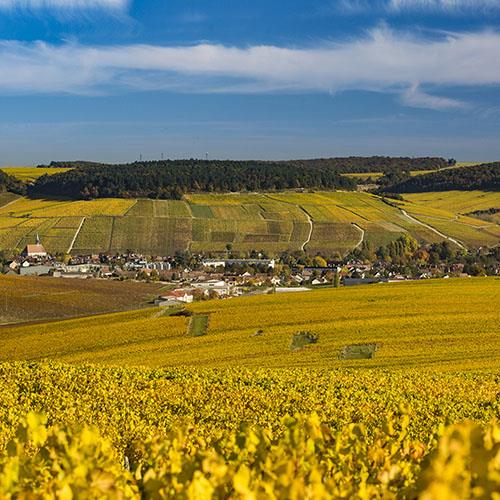EXPERIENCE CHABLIS WINE REGION

Overview
The wine region of Chablis, located in the Yonne department of northern Burgundy, is not only famous for its amazing wines, but the village itself is warm, charming, and steeped in history. The village of Chablis is only 112 miles from Paris and is easy to explore, with far fewer visitors as one of the smallest wine districts in France.
Chablis, also known as the “Golden Gate of Burgundy” is an unassuming wine powerhouse famous for its unoaked Chardonnay wines that are enjoyed all over the world. And with just over 2,500 residents, nearly everyone in Chablis is involved in the production of wine. Only when the wine comes from this small wine region can it be called Chablis. If not, it is not Chablis wine.
The Chablis wine region is divided into different areas. You have the Chablis Grand Cru, Chablis Premier Cru, Chablis and Petit Chablis vineyards. The Chablis Grand Cru is generally the most popular. The wine from these vineyards is therefore often the most prestigious. The wine in Chablis is very dry and can be perfectly combined with fish. It is also called oyster water because of the excellent combination between the wine and the shellfish.



Things to See and Do
Noël Gate: As you approach Chablis, you will be greeted by two circular towers. The towers date back to 1775 and were reconstructed in the same location of the village’s ancient square towers.
Saint-Martin Collegiate Church: The 13th century church was inspired by the Sens Cathedral and is one of the first Gothic churches in the area. The church is beautiful and despite multiple wars and fires, Saint-Martin has kept much of its original architecture.
The church was constructed in honor of Saint Martin, a Hungarian-born officer in the Roman army. Legend says that Martin cut his coat in half to give to a beggar. Of particular interest at Saint-Martin’s are the hundreds of horseshoes nailed there by patrons calling upon the protection of Martin, the patron saint of horses.
The Obédiencerie: The history of the Obédiencerie, and Chablis wines, dates back to the arrival of the abbots of Saint Martin de Tours to Chablis in the year 867. The relics of Saint Martin were stored in an inside niche tower of the Obédiencerie some 10 or 20 year later. Today, you can still see the exposed hiding space, surrounded by aging wines. By 1216 the wine production industry was in full swing as the first wine press of the Obédiencerie was recorded as operational. Throughout the 15th-17th centuries, the Obédiencerie was the largest wine producer in Chablis.
Domaine Laroche: Since 1850, the Laroche family has been the leader of wine production in Chablis. The family also owns a stunning hotel that is a converted 18th-century mill along the Serein River. Right next door is the Laroche headquarters which is located in the oldest building in Chablis - the Obédiencerie is where 9th-century monks made the very first Chablis wines.
A tour through the Laroche winery offers great insight into the history and wine making process, highlighting how a proper Chablis can’t have too many oaky notes. It was explained that Chardonnay grapes are really very delicate and they don’t want to mask the natural taste of the wine with too much oak flavor. The winery only uses French oak sourced from the center and east of France. The Chablis spends between 7 to 12 months in the oak barrels.

Wine Tasting in Chablis
Chablis offers dozens of wineries where you can taste the Chablis, visit the wine cellars, and discover the grapes. There are many wineries right in the center of Chablis, such as Vincent Dauvissat Earl, Albert Bichot, Domaine Pinson Chablis, and Domaine Jean Collet et Fils, to name a few. However, there are also so many more wineries outside the city. Exploring outside the city offers a great opportunity to see the houses between the vineyards. Some nice Chablis wineries outside the city include Domaine de la Meuliere, Comaine Brocard, Clotilde Davenne, and Domaine Massive, along with many others.
Many wineries are closed on Sundays. You can generally just walk in, especially at larger wineries. However, we do suggest calling ahead if you plan to visit the small Chablis wineries.

Cycling and Hiking Between Vineyards
The Chablis wine region offers several beautiful cycling routes that can take you between the vineyards and allow you to enjoy the view. It is worth noting that sometimes these routes can be strenuous with the hills, however electric bike rentals are also available.
The cycling routes include standard wineries, and oftentimes they work directly with the bicycle rental company, and therefore open when you rent a bike.
In addition to cycling through the vineyards, you can also enjoy hiking through the vineyards. There are numerous beautiful walks that leave from Chablis. There are short walks from an hour to 80 minutes, as well as longer walks from 5 miles to 20 miles. The tourism office in the center of town offers some great information on the different hikes available.

Village of Chablis
Chablis is a beautiful old town and so worth taking time to discover. As soon as you enter the center over a medieval bridge, you see the charming medieval houses with lavender-blue shutters. Small shops with colored facades and ornate letters lie on the main streets. Among the highlights in the village are the churches of Saint-Pierre and Saint-Martin. If you walk through the winding streets towards the cathedral, you will pass several wineries, small boutiques and hidden romantic hotels. Also take note of the traditional wine press, a historic monument for the village.
One of the most beautiful buildings in Chablis is castle Domaine Long-Depaquit, located in the middle of the city. The castle is a wine estate and is now owned by the Albert Bichot winery. You can also do a wine tasting here.

Visit other Wine Villages in the Area
Chablis is also called the gateway to Burgundy and indeed, after Chablis, the Burgundian landscape begins. Full of vineyards, cute villages and delicious food. In the vicinity of Chablis, you will also find a lot of other wine villages such as Irancy, Saint-Bris-le-Vineux, and Chitry.
In these wine villages in the Yonne you won’t find Chablis, but a lot of other excellent wines. Each village is known for a different type of wine. In Irancy, for example, light red wine with a lot of tannins is made, the white wine from Chitry looks like Chablis and the Saint-Bris from Saint-Bris-le-Vineux is really wonderfully fresh. Get in the car and drive from village to village in search of your favorite wine.